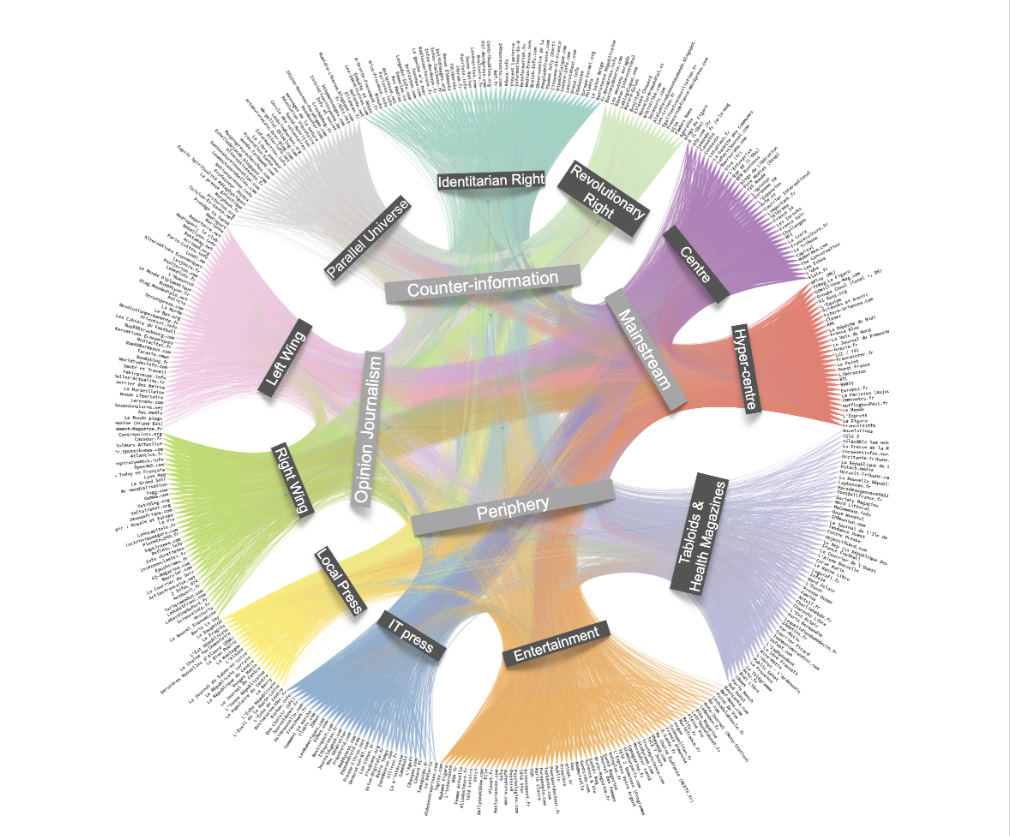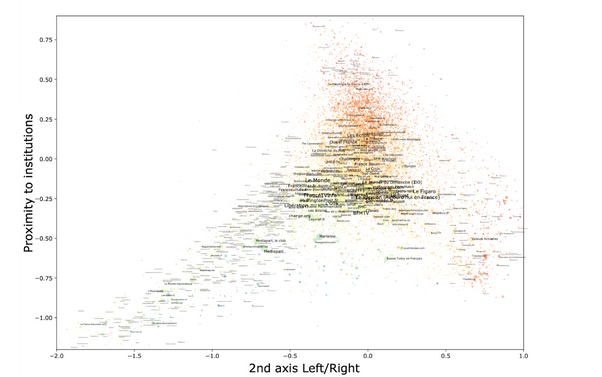


Enforcing Constitutions: A Democratic Undertaking?
12 February 2022
Care Earnings in the United States and 24 European Countries
12 February 2022by Dominique Cardon, Jean-Philippe Cointet, Pedro Ramaciotti Morales, médialab
Following an initial study conducted in 2018 in collaboration with Sciences Po’s School of Journalism and the Montaigne Institute – The digital commons and fake news: a Franco-American comparison – the médialab continued the research to extend its analysis of the French media ecosystem: Uncovering the structure of the French media ecosystem(1)Jean-Philippe Cointet, Dominique Cardon, Andreï Mogoutov, Benjamin Ooghe-Tabanou, Guillaume Plique, and Pedro Ramaciotti Morales, 7th International Conference in Computational Social Sciences, 2021. The emergence of a French-style Fox News, the influence of fake news on the upcoming presidential elections, the threat of media polarisation, and hate speech on social networks are among the many ills that plague the digital commons and that are considered a serious threat to democracy. Hence the importance of a structural perspective on the French digital commons: taking a step back to understand its form, its dynamic, and self-regulation.
The Three Floors of the Digital Commons
To capture the complexity of the French information ecosystem’s architecture and its circulation pathways, it is important to take the measure of its diversity first. Three identifiable layers structure it: the authority of the information coming from the ‘press, TV and radio’, the influence derived from the circulation of this information, notably on Twitter, and the conversation, especially on Facebook, which develops in a more fragmented and hidden way within the relational niches produced by users (see figure below).
The three layers of the information space and the tools to analyse them
(Hyphe, the Twitter API, and Crowdtangle, which provide access to public content on Facebook)
 The visibility of content and actors in each layer results from the complex interactions that link social network users and media to each other. Thus, the digital space is not a smooth surface that equally exposes everyone to all sources of information. The production of information, its visibility, and the way it inhabits different parts of the web depend on the way journalists, politicians, and new voices from the web construct and shape the information circuits.
The visibility of content and actors in each layer results from the complex interactions that link social network users and media to each other. Thus, the digital space is not a smooth surface that equally exposes everyone to all sources of information. The production of information, its visibility, and the way it inhabits different parts of the web depend on the way journalists, politicians, and new voices from the web construct and shape the information circuits.
A Self-Organising Order
The structure of the upper stratum, composed of primary news sites, is organised according to the authority that various ‘media’ acquire. This can be measured via the recognition network that journalists produce when they quote each other in their articles.
Analysis of the topology formed by 20,992 hypertext links exchanged between the articles of our body of 421 French media sources reveals the structure of information producers. Whether the commentary is positive or negative, when an article cites a source through a hypertext link it is giving credit – i.e. authority – to the cited site. This recognition is targeted and the measure of this credit distinguishes between the citer and the cited.
Grouping sites that quote each other into a same ‘block’ using a dedicated algorithm(2)The stochastic block model (SBM), Peixoto TP. Hierarchical block structures and high-resolution model selection in large networks. Physical Review X. 2014 March. yields a division of the media by citation links according to the credit that media groups grant one another.
The visualisation below shows various media groups gathered according to the profession’s criteria for legitimacy, as well as the flow of credits between groups. It reveals the existence of four media continents.
La visualisation ci-dessous donne une représentation des différents groupes de médias rassemblés en fonction des critères de légitimité mis en œuvre au sein de la profession et figure les flux de crédits entre groupes. Elle révèle l’existence de quatre continents médiatiques.
The French media wheel
organised according to the distribution and direction of hyperlinks between articles
Four Continents
We can thus distinguish, at the highest level of this classification, between the ‘mainstream media’, ‘opinion journalism’, and ‘counter information’. Peripheral to these is the specialised press (which we do not explore here).
The ‘mainstream’
The most striking observation is that the French media form a particularly unequal hierarchical system. Most of the hyperlinks in the media ecosystem point to the mainstream media block. On the other hand, the main French press, radio and television media (Le Monde, Le Figaro, Europe 1, BFM TV) composing this block, with large audiences, only give credit selectively (see figure 3).
The professional practices and norms observed by journalists in newsrooms explain how the French media system regulates itself by exercising a form of control over the entire ecosystem: mainstream media are highly disciplined when handling information from the counter-information space. Typically, when evaluating questionable information, fact-checkers use screenshots to refer to a questionable source rather than explicitly quote and link to it.
Opinion Journalism
Opinion journalism covers the second set of high-level continents: it includes websites with strong political viewpoints. At the margins of mainstream media, opinion journalism is divided into two distinct subspaces: one on the right (Causeur, Valeurs actuelles, Atlantico, etc.) and the other on the left (Mediapart, L’Humanité, Le Monde diplomatique, etc.). Newer politicised media is often exclusively digital and exerts critical pressure on the dominant media continent. These publications are sufficiently integrated into the dominant media landscape to receive links from both the right-wing and left-wing traditional media.
The Counter-Information
The counter-information space shows the most striking pattern of connectivity, as it receives almost no links from the rest of the ecosystem, but quotes extensively from the media in the other spaces. Counter-information sites are peripheral in the information ecosystem, because they cite mainstream media but receive nothing in return. Deeper analysis of the counter-information space reveals three sub-blocks that we have labelled Parallel Universe, Revolutionary Right and Identitarian Right. It is striking that this block of automatically detected (by the aforementioned SBM method) counter-information is very similar to the one identified via a manual analysis by Le Monde fact-checkers to assess the reliability of information sources according to the profession’s criteria.
Citation flows between major categories of the wheel
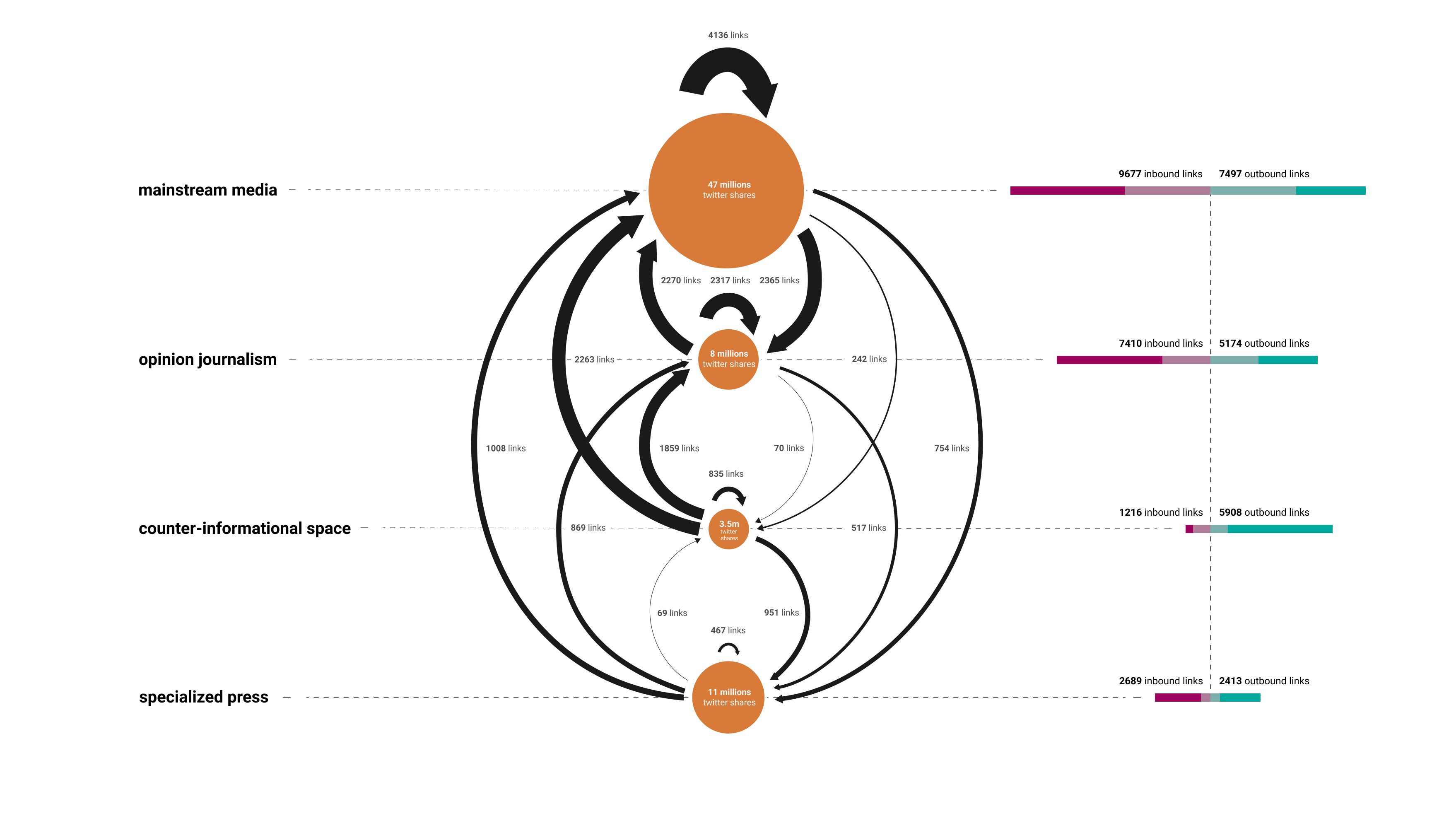 A Hierarchy of Social Network Visibility
A Hierarchy of Social Network Visibility
This mapping reveals a highly hierarchical French media landscape, which contrasts with the typically horizontal representations of site networks. This asymmetry in hypertext links is compounded by a very unequal distribution of content visibility from each continent.
The mainstream media attracts the vast majority of the attention of online users, as shown by our measures based on URL shares on Facebook and Twitter. In the French case – and unlike the situation in the US – the peripheral position of counter-information sites in the media ecosystem is not counterbalanced by significant audience success.
Distribution of the attention and reactions generated on social networks by the content produced in the 11 blocks and 4 continents, on Twitter and Facebook.
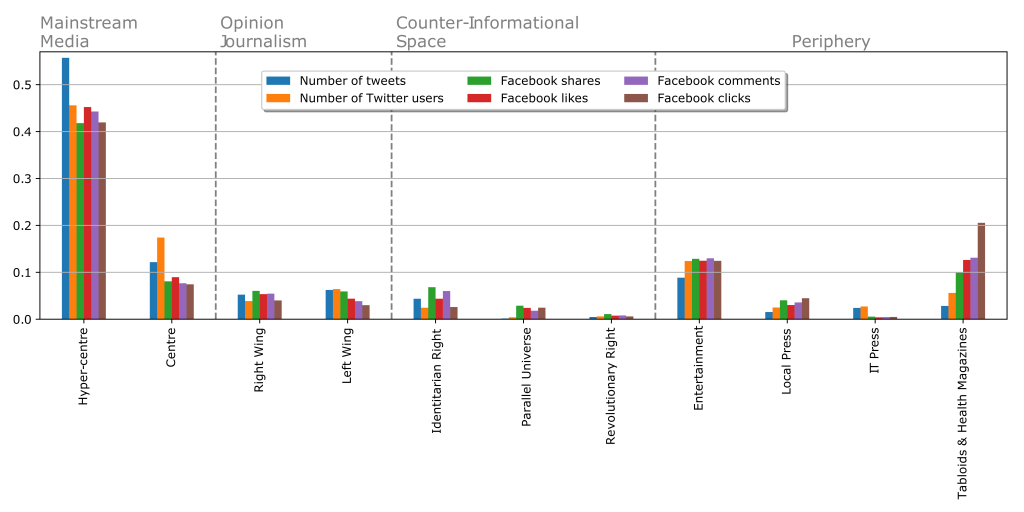 Activism Versus Visibility: the Moderation Premium
Activism Versus Visibility: the Moderation Premium
Is the French press becoming more right-wing? Are new actors ‘stretching’ the ideological distribution of the media landscape? To assess the ideological ‘bias’ of news sources in a systematic way, we calculate an ‘ideological score’ for 368,000 Twitter users in France. Each individual is positioned in a latent ideological space (see figure below) depending on his or her connection to French members of parliament and senators who have an active Twitter account(3)cf.1.
The second dimension of this space is easily interpreted and correlates strongly with the right/left economic dimension as defined in the Chapel Hill expert survey(4)Bakker R, Hooghe L, Jolly S, Marks G, Polk J, Rovny J, Steenbergen M, and Vachudova MA. 2020. “2019 Chapel Hill Expert Survey.” University of North Carolina, Chapel Hill..
Distribution of the ideological score of users on Twitter
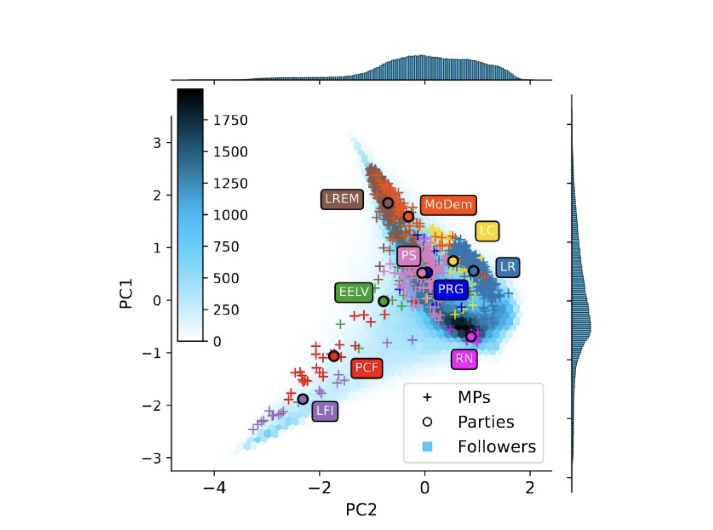
Reading note: The second dimension distributes parties and Twitter accounts along the right/left dimension. The coloured circles correspond to the average position of representatives of the 10 main parties.
This enables an extrapolation from the scores to all the media URLs shared on Twitter to account for the distribution on the right/left scale of the visible informational content.
We performed a simple experiment: we divided our population of accounts into 9 equal-sized groups from the most left-wing to the most right-wing. A raw count of the volume of URLs shared by users from each ideological grouping shows a strongly bimodal distribution that reveals the hyperactivity of users located at the extremes of the political spectrum (blue histogram in the figure below). But if we weight this number of tweets by the number of followers of these accounts, it appears that the shared URLs generate a modest number of views. The estimated exposure is much higher at the centre of the political spectrum, where the modest activity of the accounts is largely compensated by their very high visibility (salmon histogram in the figure below). Social networks, and mainly Twitter, can thus create a ‘distorting prism’ that impacts the political-media landscape(5)Bail (Chris), Breaking the Social Media Prism. How to Make Our Platforms Less Polarizing, Princeton, Princeton University Press, 2021.. The activism of Twitter accounts located at the extreme masks and silences the more moderate Twitter’s accounts.
L’activisme des comptes Twitter situés aux extrêmes contribue à masquer et à rendre silencieux les comptes Twitters plus modérés.
Ideological distribution of informational content shared on Twitter
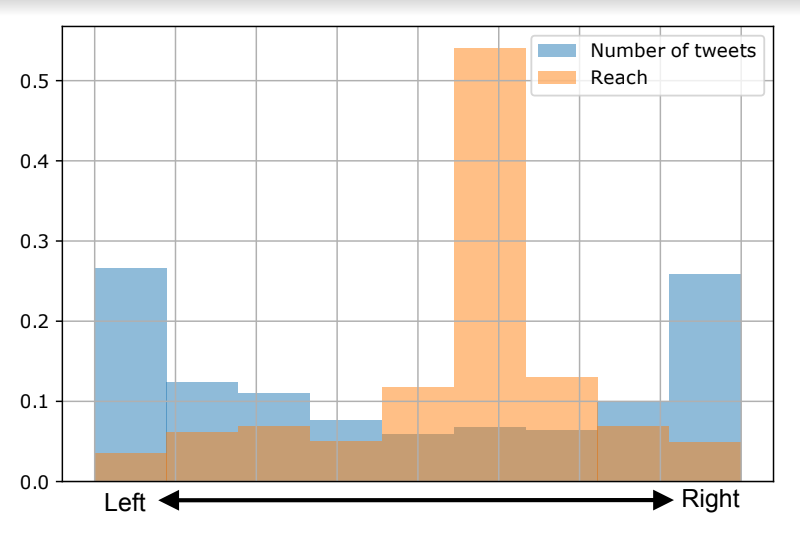 This moderation premium appears in another mapping (see figure below) showing all the domains shared on Twitter that are located in the centre of gravity of the Twitter accounts that shared their URLs(6)Cointet, J.P., Morales, P.R., Cardon, D., Froio, C., Mogoutov, A., Ooghe, B. and Plique, G., 2021. De quelle (s) couleur (s) sont les Gilets jaunes? Plonger des posts Facebook dans un espace idéologique latent. Statistique et Société. While a great diversity of strongly politicised media is apparent on both the right and left, we are clearly not in a situation of structural asymmetry, as is the case in the United States(7)Benkler Y, Faris R, Roberts H. Network propaganda: Manipulation, disinformation, and radicalization in American politics. Oxford University Press; 2018where the far right has ‘detached’ from the rest of the media. In France, the centre continues to attract most of the visibility and authority.
This moderation premium appears in another mapping (see figure below) showing all the domains shared on Twitter that are located in the centre of gravity of the Twitter accounts that shared their URLs(6)Cointet, J.P., Morales, P.R., Cardon, D., Froio, C., Mogoutov, A., Ooghe, B. and Plique, G., 2021. De quelle (s) couleur (s) sont les Gilets jaunes? Plonger des posts Facebook dans un espace idéologique latent. Statistique et Société. While a great diversity of strongly politicised media is apparent on both the right and left, we are clearly not in a situation of structural asymmetry, as is the case in the United States(7)Benkler Y, Faris R, Roberts H. Network propaganda: Manipulation, disinformation, and radicalization in American politics. Oxford University Press; 2018where the far right has ‘detached’ from the rest of the media. In France, the centre continues to attract most of the visibility and authority.
Immersion of information producers in the latent ideological space
Sciences Po’s medialab director Dominique Cardon focuses on the connection between new technologies and social, political, and cultural technologies. He specifically studies forms of sociability, production, and dissemination of knowledge, and public expression via new media: social networks, blogs, wiki, etc. He specifically analyzes the political dimensions of digital technology. Finally, he seeks to uncover how algorithms are impacting us. Jean-Philippe Cointet, Associate Professor at the medialab, develops digital methods for the social sciences. He specializes in the analysis and visualization of bodies of text. His empirical work leads him to work in various fields: scientific communities, media, social networks, online commentary, political speeches, etc. Pedro Ramaciotti Morales is a researcher in computational social sciences at médialab, where he focuses on the analysis of social networks, using computer science and applied mathematics methods. Within the ‘European Polarisation Observatory’ of CIVICA, he analyses the opinions structuring social networks in Europe to deepen understanding of phenomena such as polarisation, the influence of algorithms, and informational dynamics.
Notes
| ↑1 | Jean-Philippe Cointet, Dominique Cardon, Andreï Mogoutov, Benjamin Ooghe-Tabanou, Guillaume Plique, and Pedro Ramaciotti Morales, 7th International Conference in Computational Social Sciences, 2021 |
|---|---|
| ↑2 | The stochastic block model (SBM), Peixoto TP. Hierarchical block structures and high-resolution model selection in large networks. Physical Review X. 2014 March. |
| ↑3 | cf.1 |
| ↑4 | Bakker R, Hooghe L, Jolly S, Marks G, Polk J, Rovny J, Steenbergen M, and Vachudova MA. 2020. “2019 Chapel Hill Expert Survey.” University of North Carolina, Chapel Hill. |
| ↑5 | Bail (Chris), Breaking the Social Media Prism. How to Make Our Platforms Less Polarizing, Princeton, Princeton University Press, 2021. |
| ↑6 | Cointet, J.P., Morales, P.R., Cardon, D., Froio, C., Mogoutov, A., Ooghe, B. and Plique, G., 2021. De quelle (s) couleur (s) sont les Gilets jaunes? Plonger des posts Facebook dans un espace idéologique latent. Statistique et Société |
| ↑7 | Benkler Y, Faris R, Roberts H. Network propaganda: Manipulation, disinformation, and radicalization in American politics. Oxford University Press; 2018 |


